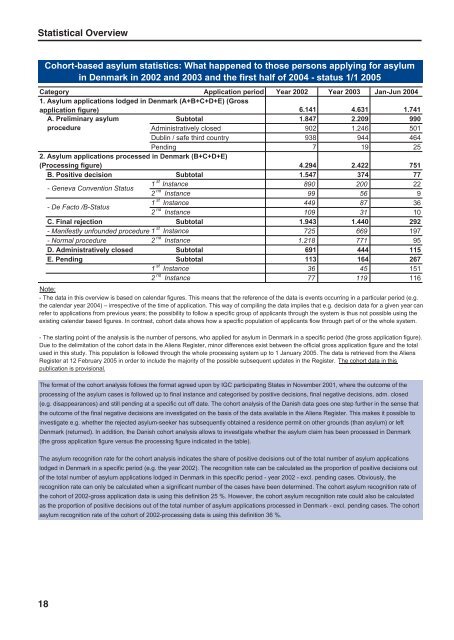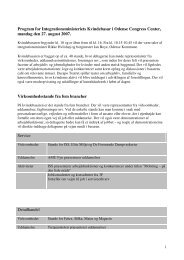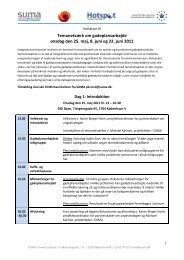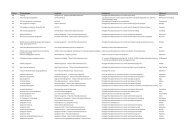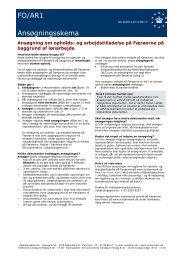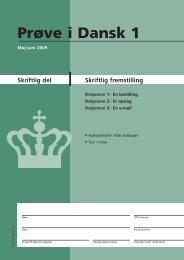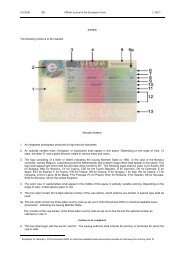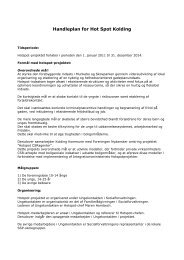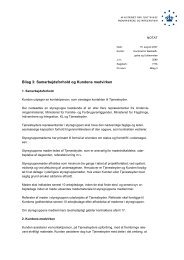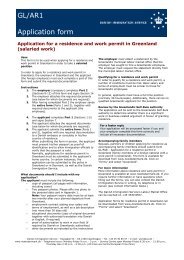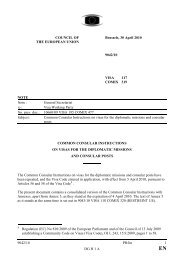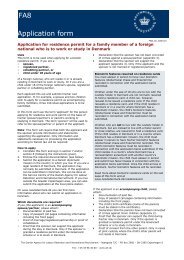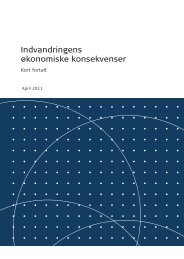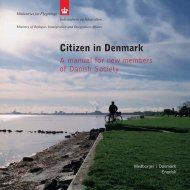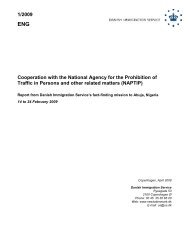Statistical Overview - Ny i Danmark
Statistical Overview - Ny i Danmark
Statistical Overview - Ny i Danmark
You also want an ePaper? Increase the reach of your titles
YUMPU automatically turns print PDFs into web optimized ePapers that Google loves.
<strong>Statistical</strong> <strong>Overview</strong><br />
Cohort-based asylum statistics: What happened to those persons applying for asylum<br />
in Denmark in 2002 and 2003 and the first half of 2004 - status 1/1 2005<br />
Category Application period Year 2002 Year 2003 Jan-Jun 2004<br />
1. Asylum applications lodged in Denmark (A+B+C+D+E) (Gross<br />
application figure)<br />
6.141 4.631 1.741<br />
A. Preliminary asylum<br />
Subtotal 1.847 2.209 990<br />
procedure<br />
Administratively closed 902 1.246 501<br />
Dublin / safe third country 938 944 464<br />
Pending 7 19 25<br />
2. Asylum applications processed in Denmark (B+C+D+E)<br />
(Processing figure)<br />
4.294 2.422 751<br />
B. Positive decision Subtotal 1.547 374 77<br />
- Geneva Convention Status<br />
- De Facto /B-Status<br />
1 st Instance<br />
1 st Instance<br />
890<br />
449<br />
200<br />
87<br />
22<br />
36<br />
2 nd Instance<br />
2 nd Instance<br />
99<br />
109<br />
56<br />
31<br />
9<br />
10<br />
C. Final rejection Subtotal 1.943 1.440 292<br />
- Manifestly unfounded procedure 1 st Instance 725 669 197<br />
- Normal procedure 2 nd Instance 1.218 771 95<br />
D. Administratively closed Subtotal 691 444 115<br />
E. Pending Subtotal 113 164 267<br />
1 st Instance 36 45 151<br />
2 nd Instance 77 119 116<br />
Note:<br />
- The data in this overview is based on calendar figures. This means that the reference of the data is events occurring in a particular period (e.g.<br />
the calendar year 2004) – irrespective of the time of application. This way of compiling the data implies that e.g. decision data for a given year can<br />
refer to applications from previous years; the possibility to follow a specific group of applicants through the system is thus not possible using the<br />
existing calendar based figures. In contrast, cohort data shows how a specific population of applicants flow through part of or the whole system.<br />
- The starting point of the analysis is the number of persons, who applied for asylum in Denmark in a specific period (the gross application figure).<br />
Due to the delimitation of the cohort data in the Aliens Register, minor differences exist between the official gross application figure and the total<br />
used in this study. This population is followed through the whole processing system up to 1 January 2005. The data is retrieved from the Aliens<br />
Register at 12 February 2005 in order to include the majority of the possible subsequent updates in the Register. The cohort data in this<br />
publication is provisional.<br />
The format of the cohort analysis follows the format agreed upon by IGC participating States in November 2001, where the outcome of the<br />
processing of the asylum cases is followed up to final instance and categorised by positive decisions, final negative decisions, adm. closed<br />
(e.g. disappearances) and still pending at a specific cut off date. The cohort analysis of the Danish data goes one step further in the sense that<br />
the outcome of the final negative decisions are investigated on the basis of the data available in the Aliens Register. This makes it possible to<br />
investigate e.g. whether the rejected asylum-seeker has subsequently obtained a residence permit on other grounds (than asylum) or left<br />
Denmark (returned). In addition, the Danish cohort analysis allows to investigate whether the asylum claim has been processed in Denmark<br />
(the gross application figure versus the processing figure indicated in the table).<br />
The asylum recognition rate for the cohort analysis indicates the share of positive decisions out of the total number of asylum applications<br />
lodged in Denmark in a specific period (e.g. the year 2002). The recognition rate can be calculated as the proportion of positive decisions out<br />
of the total number of asylum applications lodged in Denmark in this specific period - year 2002 - excl. pending cases. Obviously, the<br />
recognition rate can only be calculated when a significant number of the cases have been determined. The cohort asylum recognition rate of<br />
the cohort of 2002-gross application data is using this definition 25 %. However, the cohort asylum recognition rate could also be calculated<br />
as the proportion of positive decisions out of the total number of asylum applications processed in Denmark - excl. pending cases. The cohort<br />
asylum recognition rate of the cohort of 2002-processing data is using this definition 36 %.<br />
18


